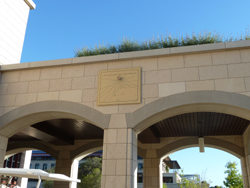 [photo courtesy of Kathleen Gust, Terman Engineering Library, Stanford Univ]
|
In 1995 Professor Emeritus Bracewell designed a vertical declining dial for the south face of the Terman Engineering Building at his Stanford University home campus in Palo Alto. But the building was torn down in 2011 and by March 2012 nothing but landscaping of the new Terman Park remained. Fortunately Prof. Ronald Bracewell’s sundial once again casts its solar time on the south wall of the Stanford Jen-Hsun Huang Engineering Center. Both the Huang and old Terman building have similar south-south-west alignments allowing the dial to be remounted without adjustment. [http://library.stanford.edu/blogs/stanford-libraries-blog/2013/04/sundial-returns-engineering-center].
Instead of a typical gnomon, Bracewell chose to use an oculus: a disc with a central hole. Standing 8 cm in front of the dial, the disc creates a shadow with a bright dot of sunlight in the center for telling both time and season. The hour lines are offset by 2 min 40 sec to account for the longitude of the Stanford campus and the hour lines themselves are laid out not as straight lines, but as analemma curves (the figure 8 pattern of the sun’s seasonal movement), with spring colored in green, summer in red, autumn in orange, and winter in blue. The analemma corrects for the “Equation of Time” allowing Bracewell to create an accurate clock-telling sundial.
The motto “Caelum Scruntando Leges Motus Didicmus” translates to “We learn the laws of motion by studying the heavens”. And with a bit of subtle math, “d/dt ≠ 0” on the dial plate, one could interpret this to mean “Time changes all things”. While Dr. Ronald N. Bracewell designed the sundial, his son Mark C. Bracewell constructed it. Both their initials can be found at the bottom of the dial.
Professor Ronald Bracewell of Stanford University was an early pioneer in radio astronomy applying his background of electrical engineering, ionospheric physics and radio wave propagation to the new realm of radio astronomy. He joined the Stanford faculty in 1955, where he ultimately held the Lewis M. Terman professorship. [Short biography at: http://news.stanford.edu/news/2007/november14/memlbrace-111407.html]
In 1961 he created an “X” array (called a “Chris-Cross array” for W.R. “Chris” Christiansen) of 32 10-foot diameter dish antennas to form a radio spectroheliograph nestled in the hills of Palo Alto, California. The radio telescope operating at a wavelength of 10cm produced daily maps of solar radio activity that NASA used during the Apollo moon landings. But Dr. Bracwell had other solar interests. He was a sundialist as well.
 [photo courtesy of Kathleen Gust, Terman Engineering Library, Stanford Univ]
|
Between 1982 and1984 he designed a sundial for Stanford’s overseas campus at Villa Il Salviatino in Florence. Over a decade later now as Professor Emeritus Bracewell, he began the design of a vertical declining dial for the south face of the Terman Engineering Building at his Stanford University home campus in Palo Alto. In April 2013 it was remounted on the south bridgeway of the Jen-Hsun Huang Engineering Center. [photo courtesy of Kathleen Gust, Terman Engineering Library, Standford Univ.]
Bracewell’s radio telescope, now demolished, may have a second life as a sundial as well. The Very Large Array (VLA) of the National Radio Astronomical Observatory (NRAO) in New Mexico is planning a memorial to Dr. Bracwell who passed away in 2007. The plan is to create a horizontal gnomonic sundial at the entrance of the NRAO visitor center using the 6-foot antenna pillars from Bracewell’s early Stanford radio telescope. [You can support this effort at http://www.razoo.com/story/Bracewell ]
As a footnote, in January 1980 Dr. Woodruff (Woody) T. Sullivan III interviewed Prof. Ron Bracewell as part of a monumental documentation project of 225 founders of 20th century radio astronomy. The collection of interviews made by Sullivan during his 30 years of research for the basis for his book, Cosmic Noise: A History of Early Radio Astronomy (Cambridge University Press, 2009). [http://www.nrao.edu/archives/Sullivan/sullivan.shtml ].
Dr. Sullivan, an avid sundialist, designed a large vertical declining dial for the University of Washington in 1994 [ http://sundials.org/index.php/component/sundials/onedial/117 ] and hosted two annual conferences of the North American Sundial Society in Seattle in 1998 and 2011. [ http://sundials.org/index.php/features/nass-conferences ]
